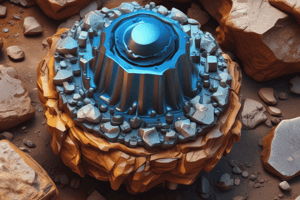Podcast
Questions and Answers
What type of geological formation can cause significant damage to a drill bit's cutting structure?
What type of geological formation can cause significant damage to a drill bit's cutting structure?
- Alternating soft and hard rock layers (correct)
- Sandy soil layers
- Homogeneous hard rock layers
- Uniform soft rock layers
What is a potential consequence of drilling through interbedded layers?
What is a potential consequence of drilling through interbedded layers?
- Enhanced drill bit lifespan
- Increased drilling speed
- Consistent drilling resistance
- Damage to the drill bit (correct)
Which scenario is most likely to lead to drill bit failure?
Which scenario is most likely to lead to drill bit failure?
- Drilling through alternating layers of soft and hard rock (correct)
- Drilling through liquid formations
- Drilling through layers of soft material
- Drilling through a single layer of hard rock
What characteristic of a drilling formation increases the risk of drill bit damage?
What characteristic of a drilling formation increases the risk of drill bit damage?
What type of drilling condition is likely to exacerbate wear on drill bits?
What type of drilling condition is likely to exacerbate wear on drill bits?
What does the void space or porosity of a rock represent?
What does the void space or porosity of a rock represent?
How is porosity expressed in geological terms?
How is porosity expressed in geological terms?
What is the significance of porosity in geological formations?
What is the significance of porosity in geological formations?
Which of the following can affect the porosity of a rock?
Which of the following can affect the porosity of a rock?
What is the relationship between porosity and fluid retention in rocks?
What is the relationship between porosity and fluid retention in rocks?
Flashcards are hidden until you start studying
Study Notes
Drilling Through Geological Formations
- Drilling through formations with alternating soft and hard rock layers can lead to damage in the drill bit's cutting structure.
- Variations in rock hardness affect the drilling efficiency and durability of the equipment used.
- Interbedded layers can create uneven wear on the drill bit, causing premature failure or reduced performance.
- The hardness difference between layers influences the rate of penetration and overall drilling dynamics.
- Using the appropriate drill bit design is essential for handling challenging geological conditions effectively.
Drilling Through Geological Formations
- Drilling in formations with varying hardness can lead to significant damage of the drill bit due to alternating soft and hard rock layers.
- The cutting structure of the drill bit is particularly susceptible to wear and tear in interbedded layers when hardness differentials are pronounced.
Void Spaces in Rocks and Soil
- The measure of void spaces or pores within a rock or soil is referred to as porosity.
- Porosity is expressed as a percentage of the total volume of the material.
- It indicates the capacity of a rock to hold fluid, which has implications for water, oil, and gas storage in geological formations.
Studying That Suits You
Use AI to generate personalized quizzes and flashcards to suit your learning preferences.



